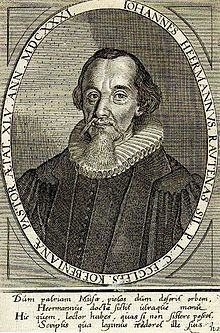
Johann Sebastian Bach composed the church cantata Mein Herze schwimmt im BlutBWV 199 in Weimar between 1712 and 1713, and performed it on the eleventh Sunday after Trinity, 12 August 1714. It is a solo cantata for soprano.

Johann Sebastian Bach composed the church cantata (Bach) Wo soll ich fliehen hin, BWV 5, in Leipzig for the 19th Sunday after Trinity and first performed it on 15 October 1724. It is based on the penitential hymn "Wo soll ich fliehen hin" by Johann Heermann.

Sechs Chorale von verschiedener Art: auf einer Orgel mit 2 Clavieren und Pedal vorzuspielen, commonly known as the Schübler Chorales, BWV 645–650, is a set of chorale preludes composed by Johann Sebastian Bach. Johann Georg Schübler, after whom the collection came to be named, published it in 1747 or before August 1748, in Zella St. Blasii. At least five preludes of the compilation are transcribed from movements in Bach's church cantatas, mostly chorale cantatas he had composed around two decades earlier.
Chorale fantasia is a type of large composition based on a chorale melody, both works for organ, and vocal settings, for example the opening movements of Bach's chorale cantatas, with the chorale melody as a cantus firmus.

"Ach Gott, wie manches Herzeleid" is a hymn in German in 18 stanzas attributed to Martin Moller (1587). It is often catalogued as a paraphrase of the Latin "Jesu dulcis memoria", a medieval hymn attributed to Bernard of Clairvaux, but only a few lines refer directly to this song. Hymn tunes were composed for the hymn, and it is also often sung to a tune composed for "Herr Jesu Christ, meins Lebens Licht". The anonymous hymn tune of "Herr Jesu Christ, meins Lebens Licht" first appeared in Wolflein Lochamer's Lochamer-Liederbuch, printed in Nürnberg around 1455. In Leipzig in the 1720s, Johann Sebastian Bach composed settings of Lochamer's hymn based on four of his church cantatas and a sacred motet.
"Wär Gott nicht mit uns diese Zeit" is a Lutheran hymn, with words written by Martin Luther based on the Psalm 124. The hymn in three stanzas of seven lines each was first published in 1524. It was translated to English and has appeared in 20 hymnals. The hymn formed the base of several compositions, including chorale cantatas by Buxtehude and Bach.
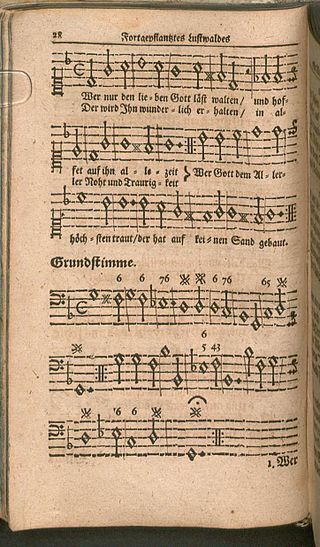
"Wer nur den lieben Gott läßt walten" is a 1641 hymn by Georg Neumark, who also composed the melody for it. It has seven verses and deals with the Christian putting their trust in God. Its author referred to it as a "Trostlied" or song of consolation and it first appeared in his Fortgepflantzer musikalisch-poetischer Lustwald. It also appeared in Johann Crüger's 1672 Praxis pietatis melica and in the first part of Johann Anastasius Freylinghausen's 1704 Geistreiches Gesangbuch. It has inspired musical settings, and is part of current German hymnals, both Protestant and Catholic.
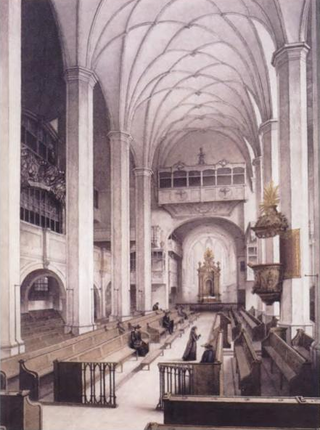
Erforsche mich, Gott, und erfahre mein Herz, BWV 136 is a church cantata by Johann Sebastian Bach. Bach composed the cantata in 1723 in Leipzig to be used for the eighth Sunday after Trinity. He led the first performance on 18 July 1723.

Bringet dem Herrn Ehre seines Namens, BWV 148, is a cantata by Johann Sebastian Bach, a church cantata for the 17th Sunday after Trinity. Bach composed it in Leipzig in 1723 or 1725.

Wo gehest du hin?, BWV 166, is a church cantata by Johann Sebastian Bach for Cantate Sunday, the fourth Sunday after Easter. Bach composed the work as part of his first cantata cycle for Leipzig and first performed it on 7 May 1724.

"Was willst du dich betrüben" is a hymn in seven stanzas by the German Baroque poet, Lutheran minister and hymn-writer Johann Heermann. The chorale was first published in 1630 during the Thirty Years' War. It is focused on trust in God, even when facing adversaries.
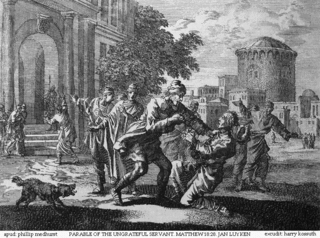
Johann Sebastian Bach composed the church cantata Was soll ich aus dir machen, Ephraim, BWV 89, in Leipzig for the 22nd Sunday after Trinity and first performed it on 24 October 1723.

Ich bin vergnügt mit meinem Glücke, BWV 84, is a church cantata by Johann Sebastian Bach. He composed the solo cantata for soprano in Leipzig in 1727 for the Sunday Septuagesima, and led the first performance, probably on 9 February 1727.
There are 52 chorale cantatas by Johann Sebastian Bach surviving in at least one complete version. Around 40 of these were composed during his second year as Thomaskantor in Leipzig, which started after Trinity Sunday 4 June 1724, and form the backbone of his chorale cantata cycle. The eldest known cantata by Bach, an early version of Christ lag in Todes Banden, BWV 4, presumably written in 1707, was a chorale cantata. The last chorale cantata he wrote in his second year in Leipzig was Wie schön leuchtet der Morgenstern, BWV 1, first performed on Palm Sunday, 25 March 1725. In the ten years after that he wrote at least a dozen further chorale cantatas and other cantatas that were added to his chorale cantata cycle.

Nur jedem das Seine, BWV 163, is a church cantata by Johann Sebastian Bach. He composed the work in Weimar for the twenty-third Sunday after Trinity and first performed it on 24 November 1715.

"O Welt, sieh hier dein Leben" is a Lutheran Passion hymn in German by Paul Gerhardt. In 16 stanzas of 6 lines, it was first published in 1647 in Johann Crüger's Praxis pietatis melica. The hymn is known as the source for chorales in Bach's Passions. It was translated to English in several versions, for example "O, World! behold upon the tree" by Catherine Winkworth in 1858.
"Warum sollt ich mich denn grämen" is a Lutheran hymn with a text by Paul Gerhardt written in 1653. It was first published that same year in the fifth edition of Johann Crüger's hymnal Praxis Pietatis Melica, set to a melody composed by Crüger. In the 1993 Protestant hymnal, Evangelisches Gesangbuch, it appears as number 370 with a melody composed by Johann Georg Ebeling, which was published with the divergent title "Warum sollt ich mich doch grämen" in Pauli Gerhardi Geistliche Andachten in 1666.
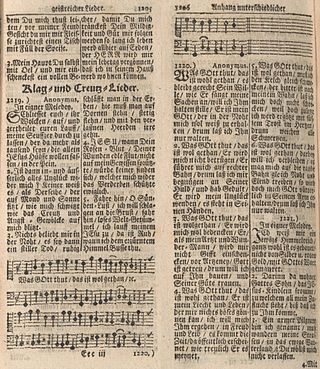
"Was Gott tut, das ist wohlgetan" is a Lutheran hymn written by the pietist German poet and schoolmaster Samuel Rodigast in 1675. The melody has been attributed to the cantor Severus Gastorius. An earlier hymn with the same title was written in the first half of the seventeenth century by the theologian Michael Altenburg.

"Ach lieben Christen seid getrost" is a Lutheran hymn in German with lyrics by Johannes Gigas, written in 1561. A penitential hymn, it was the basis for Bach's chorale cantata Ach, lieben Christen, seid getrost, BWV 114.
"Auf meinen lieben Gott" is a Lutheran hymn from the 17th century. Several hymns are sung to the same hymn tune, including "Wo soll ich fliehen hin", and it was set in compositions. The hymn was translated into English as "In God, My Faithful God". It is part of modern hymnals and songbooks.
